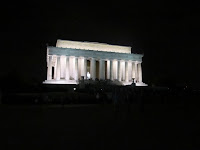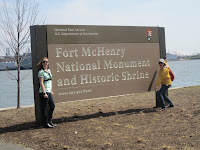 After fighting our way through D.C. traffic we made it to the hotel. After dropping our luggage off and grabbing a quick dinner we decided to go walk around and see the sights of D.C. at night since it was so balmy outside.
After fighting our way through D.C. traffic we made it to the hotel. After dropping our luggage off and grabbing a quick dinner we decided to go walk around and see the sights of D.C. at night since it was so balmy outside.  Our first stop was the White House (literally a block away from our hotel). Jess carried along my full size tripod and was taking a bunch of pictures and after about 5 minutes a guard came up and said tripods weren’t allowed on the sidewalk. I guess you can have a tripod on the street, but not the sidewalk. I think the guards were more concerned with the protestors so that’s why she got away with it for so long.
Our first stop was the White House (literally a block away from our hotel). Jess carried along my full size tripod and was taking a bunch of pictures and after about 5 minutes a guard came up and said tripods weren’t allowed on the sidewalk. I guess you can have a tripod on the street, but not the sidewalk. I think the guards were more concerned with the protestors so that’s why she got away with it for so long.
We had only planned on going to the White House because it was so close but the night was so warm and everything looked so pretty lit up at night that next thing you know we ended up at the World War II Memorial.
When I was last in D.C. in 2001, the WWII Memorial was less than a month away from the ground breaking so it was nice to see it completed. The water features are really nice.
We caught sight of the Lincoln Memorial and decided why not walk over since it looks so nice lit up at night?
Interesting fact: The statue of Lincoln, originally designed to be 10 feet tall, was later enlarged to 19 feet to prevent it from being dwarfed by its huge chamber.



We then had a very looong walk back to the hotel and I was hobbling along in pain by the time we got back. I think I need better shoes. Despite my pain, I am so glad we wandered around though because the next day the temperature quickly dropped 30 degrees and the rains and winds came.

















































